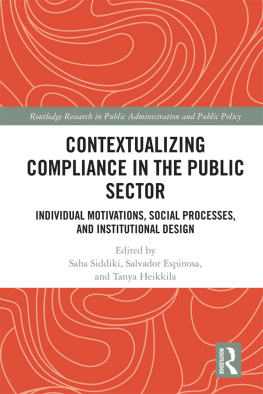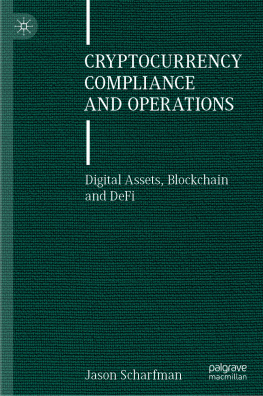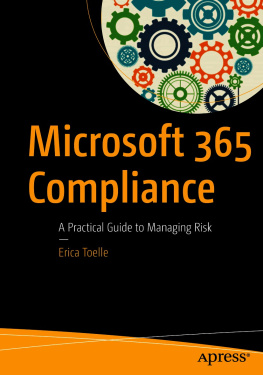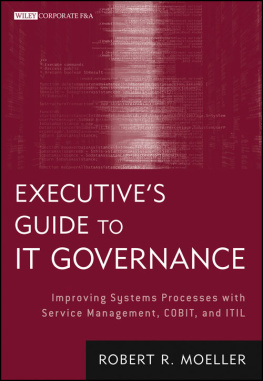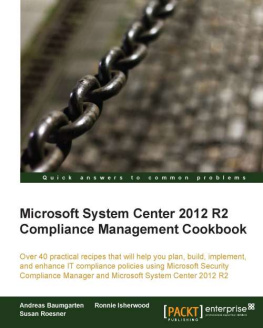

Copyright 2015 by Nitish Singh, PhD, and Thomas J. Bussen
All rights reserved. No part of this publication may be reproduced, stored in a retrieval system, or transmitted, in any form or by any means, electronic, mechanical, photocopying, recording, or otherwise, except for the inclusion of brief quotations in a review, without prior permission in writing from the publisher.
Library of Congress Cataloging-in-Publication Data
Singh, Nitish, author.
Compliance management : a how-to guide for executives, lawyers, and other compliance professionals / Nitish Singh, PhD, and Thomas J. Bussen.
pages cm
ISBN 978-1-4408-3311-3 (hardback) ISBN 978-1-4408-3312-0 (ebook) 1. Corporate governanceLaw and legislationUnited States. 2. Commercial lawUnited States. 3. Business ethicsUnited States. I. Bussen, Thomas J. II. Title.
KF1422.S56 2015
658.12dc23 2014041800
ISBN: 978-1-4408-3311-3
EISBN: 978-1-4408-3312-0
19 18 17 16 15 1 2 3 4 5
This book is also available on the World Wide Web as an eBook.
Visit www.abc-clio.com for details.
Praeger
An Imprint of ABC-CLIO, LLC
ABC-CLIO, LLC
130 Cremona Drive, P.O. Box 1911
Santa Barbara, California 93116-1911
This book is printed on acid-free paper 
Manufactured in the United States of America
Contents
Preface
A businesss reputation is significantly affected by the business environment: scandals, prosecutions, and investigations of any one company foster public skepticism of all business, raising the stakes for companies to have well-trained professionals and rich corporate cultures of doing the right thing. Laws and regulations impacting businesses are extensive, and professionals must be familiar with a wide variety of subjects in order to spot issues and manage compliance risks effectively.
Research also increasingly supports the notion that more compliant and ethical businesses see increased productivity across a range of measurements. The purpose of this book is to provide corporate professionals, law students, and business students with a one-stop, hands-on guide to creating and managing an effective compliance program. The book specifically outlines practical tips and best practices in compliance management. In this book we have attempted to provide a simplified understanding of compliance with various laws related to international business compliance, wage and labor compliance, environmental compliance, antitrust issues, and other areas.
However, this book provides the authors subjective evaluation of best practices for compliance. Numerous regulations are covered through the lens of compliance management. This is not meant to serve as a legal handbook, but rather as a compliance handbook. We attempt to combine our compliance expertise with expert opinions and best practices to provide practical guidance on compliance management. Thus, we sincerely hope that we provide the reader with a comprehensive understanding of various aspects of compliance management. The most important thing a reader can take away from this book is ethical knowledge and the conviction to do the right thing. We hope to continue to share ethics and compliance insights via our blog www.ethicsresources.org. We also encourage our readers to contact us with their stories, best practices, and other compliance insights, so we can create a rich discussion around these issues via our blog and other formats.
This book is divided into three major sections, which take the reader through the foundations of compliance management, critical success factors for compliance management, and an overview to compliance with specific laws.
In Section I: Importance and Foundations of Compliance Management, readers will gain an understanding of the importance of investing in a compliance program and developing a culture of doing the right thing. This section will also introduce readers to ethical foundations and ethical decision-making strategies. Finally, readers will be exposed to the role of corporate governance, corporate responsibility, and the importance of the Federal Sentencing Guidelines for Organizations (FSGO) in compliance management.
In Section II: Critical Success Factors for Compliance Management, readers will develop a better understanding of how to manage and implement an effective compliance program. Specific strategies for managing various facets of a compliance program will be outlined. We will also share examples and best practices with readers to better integrate theory and practice. More specifically, readers will learn about critical aspects of compliance management such as training and communication; preventing and investigating fraud; risk management, auditing, and control; and evaluating compliance program effectiveness.
In Section III: Mitigating Risk: A Brief on Compliance with Various Laws, readers will gain specific insights into compliance with various laws that govern different aspects of a business undertaking. This section will be useful for both a legal and nonlegal audience as it provides a simplified and brief overview of compliance with important laws applicable to a variety of organizations across industries. We will cover compliance with laws related to international business, money laundering, employment, the environment, and antitrust issues.
Finally, before we conclude we do want to acknowledge several people who helped us with research insights, cases, best practices, editorial services, and other inputs. Thank you especially to Aaron Appelbaum for providing us with constructive feedback and editorial guidance. We are also thankful to the following experts who provided us with rich insights and guidance: Kara Tan Bhala, Lyn Boxall, Steve Casazza, Ron Gieseke, Brendan Keating, Gary Levine, Michael Keating, Dr. Seung Kim, Aley Raza, Jeroen Tetteroo, and Mark Whitacre. Thank you all.
Section I: Importance and
Foundations of Compliance
Management
CHAPTER ONE
Why Doing the Right Thing Matters
Managing compliance is not just a functional necessityits a critical component needed to successfully navigate the turbulent global environment and deliver against the business strategyespecially in the wake of high profile cases and recent events around the world.
Bobby Kipp, partner, PwC
Its Monday morning, and Paul is just sitting down at the kitchen table for a cup of coffee. He opens the Wall Street Journallike he does almost every morningand lets out a small gasp. His company is on the front page, its name in big bold letters, cited for alleged compliance failures and employee misconduct. Before he can digest the information, his phone rings; his caller ID shows that its the CEO of the company. This is bad. Paul, his boss begins, have you seen the front page? Youre the head of compliance. We have to show the market that were making changes. You know how it is. Youre gone. He hangs up.
And then Paul wakes up. It was all a dreamor rather, a nightmarebut Paul knows this could be reality one day. Pauls been putting off improvements to his companys compliance program, but today he resolves to begin making improvements.
Compliance professionals and executives are not as isolated from this nightmare scenario as they once were. Regulatory pressure for effective ethics and compliance programs (hereinafter Program is used to refer to an effective ethics and compliance program) has been increasing ever since the United States Sentencing Commission (USSC) passed the Federal Sentencing Guidelines for Organizations (FSGO) in 1991. However, recent scandals involving Enron, WorldCom, Tyco, Freddie Mac, AIG, Lehman Brothers, and others, have also had a significant impact on modern regulatory compliance. These glaring misjudgments and compliance failures resulted in criminal actions that led to record fines and increased regulatory scrutiny designed to prevent future criminal violations.
Next page


